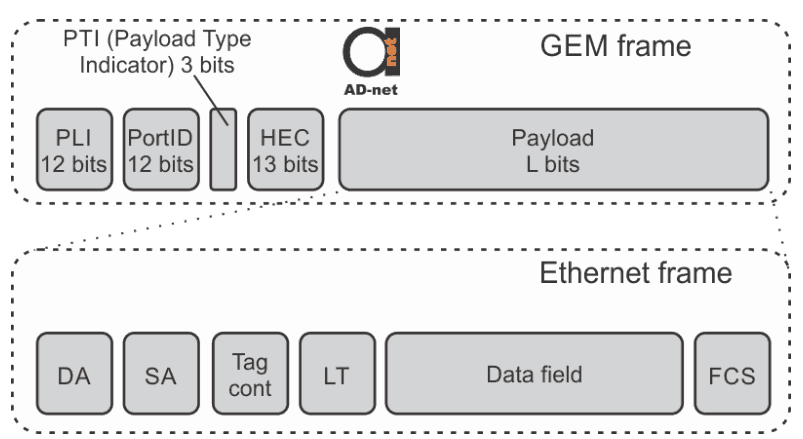The efficient encapsulation model, that is used for transportation of TDM and Ethernet traffic in GEM, is called GFP (Generic Framing Procedure). It allows GEM to encapsulate variable-length packets with minimal encapsulation overhead.

Figure 1.Mapping the alternatives of TDM octets and Ethernet frames into a GEM frame.
As Figure 1 suggests, GEM frame contains Ethernet and TDM data. In order to identify frames GEM contains 5-byte header at the beginning. It allows ignoring the alignment information between consecutive frames. As shown in Figure 1 header is made of four fields. Each field is carrying significant part of information required for successful data transmission as shown in Table 1.
Table 1.
| Name | Function |
| PLI (Payload Length Indicator) | Defines L-amount of bytes in payload part of the GEM frame. |
| Port ID | GFP port identification. |
| PTI (Payload Type Indicator) | Defines type of carrier data in the frame (might be GEM OAM message or user data). If it is user data, PTI also indicates end of the data frame. |
| HEC (Header Error Check) | GEM frame headers error checker and fixer |
Ethernet field is mapped into GEM payload and contains following fields:
-
DA (Destination Address)
-
SA (Source Address)
-
LT (Length Type)
-
Opcode (Operation code)
-
TS (Time Stamp)
-
Ethernet payload
-
FCS (Frame Check Sequence)
TDAM data is being accumulated and mapped into payload in multiple octets.
Appropriate level of encapsulation is achieved by fragmenting data in GEM frame, so no more encapsulation is required. It allows increase bandwidth significantly.


